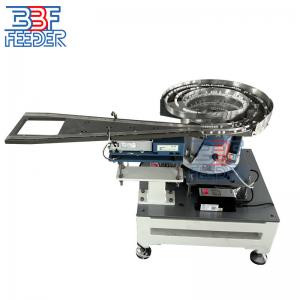
Add to Cart
Dual Channel Vibratory Bowl Feeder Bottle Crown Lid Vibrating Cap Feeder
1 . Descriptions:
When designing a bowl feeding and orienting system, it is crucial as a client and end user to effectively communicate your requirements to the designer and manufacturer. By sharing your knowledge and needs, the manufacturer can create a system that seamlessly integrates with your current processes and delivers the desired outcomes.
Understanding Your Current and Future Needs
Engage in a discussion with the manufacturer about your present production requirements and provide an outline of your future plans. This will enable the manufacturer to incorporate both aspects into the system design, resulting in a unified solution. By considering future needs during the design phase, you can minimize integration challenges and avoid costly replacements. It is essential to ensure that the manufacturer fully understands the specifications of the final product. If necessary, involve the manufacturer in the design process to allow for any favorable adjustments that their experience can contribute.
Sample Parts for Precise Design
Supplying the manufacturer with part samples is vital for achieving flawless design and production. By examining the weight, geometry, and center of gravity of the parts, the manufacturer can enhance the production process. Additionally, they can conduct tests to ensure that the vibratory bowl feeding and orienting system functions flawlessly for the specific process. Clear and concise communication with the manufacturer is crucial for achieving precise results. Implementing a well-designed system will enhance productivity and streamline processes, leading to higher returns.
Vibratory Bowl Feeders in Automotive Applications
Vibratory bowl feeders play a crucial role in the efficient assembly of various automotive products. Some examples of these products include:
Fasteners: Nuts, bolts, screws
Electrical Components: Sensors, connectors, relays
Interior Elements: Buttons, switches, clips
Exterior Features: Lights, mirrors, emblems
Engine Parts: Pistons, bearings, valves
Transmission Components: Gears, shafts
Chassis and Suspension: Springs, brackets, bushings
These components heavily rely on vibratory bowl feeders, highlighting their significance in automated production and packaging lines. Effective communication with the manufacturer is essential to ensure the optimal performance of the system and maximize productivity.
2 . Specifications:
| Product name | Vibratory Bowl Feeder |
| Material | Aluminum(AL7075), Stainless Steel(SUS304) or Based on Customers' Requirements |
| Controller | CUH,Sanki,Sinfonia,REO,Afag |
| Voltage | 220V 50HZ/110V 60Hz or Based on Customers' Requirements |
| Power | 300W/500W/1000W/1500W/2000W |
| Material Speciality | Excellent Processing Properties,High Strength, High Hardness |
| Speed | Based on Customers Requirements |
| Warranty | 2 Years |
| Certification | CE, ISO9001, ROHS |
| Lead Time | 3 Working Weeks |
3 . How Vibratory Bowl Feeders Support Medical and Pharmaceutical Applications :
Vibratory feeders offer significant benefits for the medical and pharmaceutical industries, which require high production rates and clean, sterile processes. These feeders, along with their components and functions, contribute to efficient and precise part feeding in production lines.
The Bowl: Vibratory bowls are cost-effective and can be fabricated from FDA-compliant materials like aluminum or stainless steel. Typically, stainless steel grades such as 304 or 316 are used. The bowl design can be customized as step or cascade bowls to suit specific production line setups. External or internal tracks, or both, can be incorporated for precise part feeding.
The Feeder: In pharmaceutical applications, feeders play a crucial role in maintaining consistent material throughput, introducing ingredients in the correct order, and facilitating data collection for process validation. Multiple feeders can be utilized to balance and introduce ingredients based on weight, ensuring stability and consistency.
Additional Beneficial Features: Vibratory feeders provide various additional benefits, including faster production and delivery, FDA-approved coatings for enhanced protection, minimal noise generation, and the option to attach additional components like drawers, pits, rails, and wipers to the bowl feeder.
Common Benefits: Vibratory feeders offer several general advantages. They are automated machines that enable accurate part selection and orientation. They can operate for extended periods with minimal human intervention.
In summary, vibratory feeders are an ideal solution for medical and pharmaceutical production lines, offering enhanced efficiency, cleanliness, and precision in part feeding processes.
4 . More Pictures:

